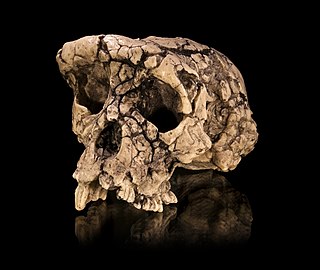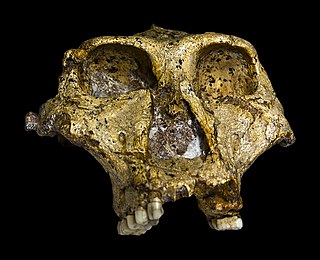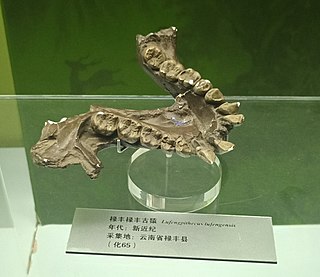
Sahelanthropus tchadensis is an extinct species of the Homininae dated to about 7 million years ago, during the Miocene epoch. The species, and its genus Sahelanthropus, was announced in 2002, based mainly on a partial cranium, nicknamed Toumaï, discovered in northern Chad.
Paleoanthropology or paleo-anthropology is a branch of paleontology and anthropology which seeks to understand the early development of anatomically modern humans, a process known as hominization, through the reconstruction of evolutionary kinship lines within the family Hominidae, working from biological evidence and cultural evidence.

Mary Douglas Leakey, FBA was a British paleoanthropologist who discovered the first fossilised Proconsul skull, an extinct ape which is now believed to be ancestral to humans. She also discovered the robust Zinjanthropus skull at Olduvai Gorge in Tanzania, eastern Africa. For much of her career she worked with her husband, Louis Leakey, at Olduvai Gorge, where they uncovered fossils of ancient hominines and the earliest hominins, as well as the stone tools produced by the latter group. Mary Leakey developed a system for classifying the stone tools found at Olduvai. She discovered the Laetoli footprints, and at the Laetoli site she discovered hominin fossils that were more than 3.75 million years old.

Proconsul is an extinct genus of primates that existed from 21 to 17 million years ago during the Miocene epoch. Fossil remains are present in Eastern Africa including Kenya and Uganda. Four species have been classified to date: P. africanus, P. gitongai, P. major and P. meswae. The four species differ mainly in body size. Environmental reconstructions for the Early Miocene Proconsul sites are still tentative and range from forested environments to more open, arid grasslands.

Paranthropus robustus is a species of robust australopithecine from the Early and possibly Middle Pleistocene of the Cradle of Humankind, South Africa, about 2.27 to 0.87 million years ago. It has been identified in Kromdraai, Swartkrans, Sterkfontein, Gondolin, Cooper's, and Drimolen Caves. Discovered in 1938, it was among the first early hominins described, and became the type species for the genus Paranthropus. However, it has been argued by some that Paranthropus is an invalid grouping and synonymous with Australopithecus, so the species is also often classified as Australopithecus robustus.

Paranthropus boisei is a species of australopithecine from the Early Pleistocene of East Africa about 2.5 to 1.15 million years ago. The holotype specimen, OH 5, was discovered by palaeoanthropologist Mary Leakey in 1959, and described by her husband Louis a month later. It was originally placed into its own genus as "Zinjanthropus boisei", but is now relegated to Paranthropus along with other robust australopithecines. However, it is also argued that Paranthropus is an invalid grouping and synonymous with Australopithecus, so the species is also often classified as Australopithecus boisei.

The Tugen Hills are a series of hills in Baringo County, Kenya. They are located in the central-western portion of Kenya.

Victoriapithecus macinnesi was a primate from the middle Miocene that lived approximately 15 to 17 million years ago in Northern and Eastern Africa. Through extensive field work on Maboko Island in Lake Victoria, Kenya, over 3,500 specimens have been found, making V. macinnesi one of the best-known fossil primates. It was previously thought that perhaps multiple species of Victoriapithecus were found, however the majority of fossils found indicate there is only one species, V. macinnesi. Victoriapithecus shows similarities to the extant subfamilies Colobinae and Cercopithecinae. However, Victoriapithecus predates the last common ancestor of these two groups and instead is thought to be a sister taxon.

Proconsul major, an extinct primate of the genus Proconsul, was possibly the ancestor of Afropithecus and showed hominid characteristics. It occurred during the early Miocene and was roughly, the size of a gorilla. The species previously referred to as Ugandapithecus major is now considered to be a synonym of Proconsul major. Prior to 2000 it was known as Proconsul major and some argue against the renaming.

Afropithecus is a genus of Miocene hominoid with the sole species Afropithecus turkanensis, it was excavated from a small site near Lake Turkana called Kalodirr in northern Kenya in 1986 and named by Richard Leakey and Meave Leakey. The estimated age of Afropithecus is between 16 and 18 million years old, which was determined with radiometric dating techniques and the geological studies conducted by Broschetto and Brown from the University of Utah. In total there are 46 recovered specimens from Kalodirr relating to Afropithecus consisting of cranial, mandible, dentition and post-cranial remains. The type specimen of Afropithecus turkanensis is KNM-WK 16999.

Kenyapithecus wickeri is a fossil ape discovered by Louis Leakey in 1961 at a site called Fort Ternan in Kenya. The upper jaw and teeth were dated to 14 million years ago. One theory states that Kenyapithecus may be the common ancestor of all the great apes. More recent investigations suggest Kenyapithecus is more primitive than that and is only slightly more modern than Proconsul, which is considered to be an ape.

Ekembo nyanzae, originally classed as a species of Proconsul, is a species of fossil primate first discovered by Louis Leakey on Rusinga Island in 1942, which he published in Nature in 1943. It is also known by the name Dryopithecus africanus. A joint publication of Wilfrid Le Gros Clark and Louis Leakey in 1951, "The Miocene Hominoidea of East Africa", first defines Proconsul nyanzae. In 1965 Simons and Pilbeam replaced Proconsul with Dryopithecus, using the same species names.

Australopithecina or Hominina is a subtribe in the tribe Hominini. The members of the subtribe are generally Australopithecus, and it typically includes the earlier Ardipithecus, Orrorin, Sahelanthropus, and Graecopithecus. All these closely related species are now sometimes collectively termed australopiths or homininians. They are the extinct, close relatives of humans and, with the extant genus Homo, comprise the human clade. Members of the human clade, i.e. the Hominini after the split from the chimpanzees, are now called Hominina.

Rusinga Island, with an elongated shape approximately 10 miles (16 km) from end to end and 3 miles (5 km) at its widest point, lies in the eastern part of Lake Victoria at the mouth of the Winam Gulf. Part of Kenya, it is linked to Mbita Point on the mainland by a causeway.

Proconsulidae is an early family of primates that lived during the Miocene epoch in Kenya, and was restricted to Africa. Members of the family have a mixture of Old World monkey and ape characteristics, so the placement in the ape superfamily Hominoidea is tentative; some scientists place Proconsulidae outside of Hominoidea in a separately superfamily Proconsuloidea, before the split of the apes and Old World monkeys.

Lufengpithecus is an extinct genus of ape in the subfamily Ponginae. It is known from thousands of dental remains and a few skulls and probably weighed about 50 kg (110 lb). It contains three species: L. lufengensis, L. hudienensis and L. keiyuanensis. Lufengpithecus lufengensis is from the Late Miocene found in China, named after the Lufeng site and dated around 6.2 Ma. It is the latest Miocene fossil ape that has been discovered in the entire world. Some researchers believe that genus Lufengpithecus could be an ancestor to African apes.
Kamoyapithecus was a primate that lived in Africa during the late Oligocene period, about 24.2-27.5 million years ago. First found in 1948 as part of a University of California, Berkeley expedition, it was at first thought to be under a form of Proconsul by C.T. Madden in 1980, but after a re-examination by Meave Leakey and associates later, the fossils were moved under a new genus Kamoyapithecus, named after the renowned fossil finder Kamoya Kimeu. The genus is represented by only one species, K. hamiltoni.

Saadanius is a genus of fossil primate dating to the Oligocene that is closely related to the common ancestor of the Old World monkeys and apes, collectively known as catarrhines. It is represented by a single species, Saadanius hijazensis, which is known only from a single partial skull tentatively dated between 29 and 28 million years ago. It was discovered in 2009 in western Saudi Arabia near Mecca and was first described in 2010 after a comparison with both living and fossil catarrhines.
Maboko Island is a small island lying in the Winam Gulf of Lake Victoria, in Nyanza Province of western Kenya. It is about 1.8 km long by 1 km wide. It is an important Middle Miocene paleontological site with fossiliferous deposits that were discovered in the 1930s. The age of the deposits is estimated to be 15 to 16 million years, and they are especially important for the abundance of primate fossils they contain.

Ekembo is an early ape (hominoid) genus found in 17- to 20-million-year-old sediments from the Miocene epoch. Specimens have been found at sites around the ancient Kisingiri volcano in Kenya on Rusinga Island and Mfangano Island in Lake Victoria. The name Ekembo is Suba for "ape" or "monkey".
















